Equipment
Build Your Own Fishing Pole Rack: A DIY 8 Steps Guide
As an avid angler, there’s nothing more frustrating than tangled lines, damaged rods, and a cluttered fishing gear storage area. Not only does it add unnecessary stress to your fishing trips, but it can also lead to costly replacements and repairs. Fortunately, there’s a simple and cost-effective solution: building your own fishing pole rack. This DIY project not only helps organize your gear but also adds a personal touch to your fishing setup, making it a practical and rewarding endeavor. In this comprehensive guide, we’ll walk you through the entire process of constructing a sturdy and functional fishing pole rack that will keep your rods safe, organized, and within easy reach.
You may also like to read “ Fishing with the Double Drop Bottom Rig” article.
The Benefits of a Homemade Fishing Pole Rack
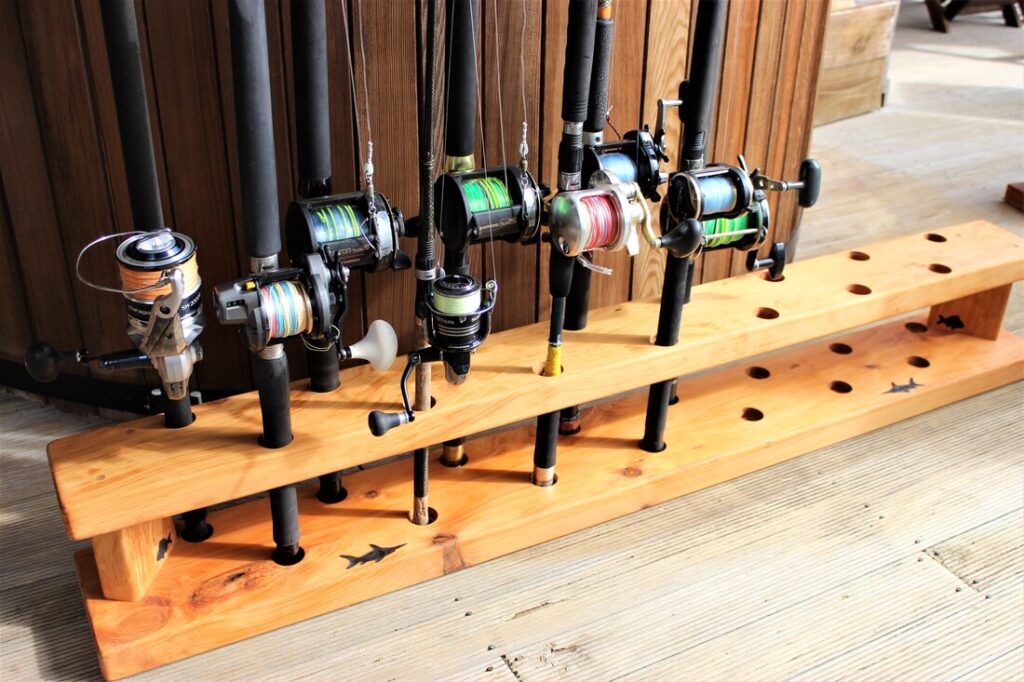
DIY Fishing Pole Rack
Before diving into the step-by-step instructions, let’s explore the advantages of having a custom-built fishing pole rack:
Organization and Accessibility
A well-designed fishing pole rack keeps your rods neatly arranged and easily accessible. No more scrambling through a tangled mess or risking damage to your precious gear. With your rods properly stored, you can quickly grab the one you need and hit the water without any hassle.
Space-Saving Solution
Most anglers have limited storage space, whether it’s in a garage, basement, or dedicated fishing room. A DIY fishing pole rack allows you to maximize the available space by utilizing vertical storage, freeing up valuable floor space for other gear or equipment.
Cost-Effective Alternative
Store-bought fishing pole racks can be expensive, especially if you have a large collection of rods. By building your own, you’ll save a significant amount of money while still achieving a high-quality and customizable solution tailored to your specific needs.
Personalization and Pride
There’s something deeply satisfying about crafting your own fishing pole rack. You can customize it to your exact specifications, choose the materials and finishes that suit your personal style, and take pride in your handiwork every time you use it.
Materials and Tools Needed
Before embarking on your DIY fishing pole rack project, gather the necessary materials and tools. Here’s a list to get you started:
Materials:
- Wood (plywood, cedar, or your preferred material)
- Wood glue
- Wood screws or nails
- Sandpaper
- Stain or paint (optional)
- Felt or rubber lining (optional)
- Dowels or PVC pipes (for rod holders)
Tools:
- Saw (hand saw, circular saw, or jigsaw)
- Drill and drill bits
- Measuring tape
- Pencil
- Clamps
- Hammer
- Sanding block or orbital sander
Note: The specific quantities and dimensions of the materials will depend on the size and design of your fishing pole rack. It’s recommended to plan ahead and make a detailed list based on your desired specifications.
Step-by-Step DIY Fishing Pole Rack Guide
Now that you have the necessary materials and tools, it’s time to roll up your sleeves and get to work. Follow these step-by-step instructions to build your very own fishing pole rack:
1. Plan and Design
Start by deciding on the size and layout of your fishing pole rack. Consider the number of rods you need to store, the available space, and your personal preferences. Sketch out a design and take accurate measurements to ensure a proper fit.
2. Cut the Pieces
Using your saw, carefully cut the wood pieces according to your measurements. Double-check each piece for accuracy before moving on to the next step.
3. Assemble the Frame
Begin by assembling the frame of your fishing pole rack. Use wood glue and screws or nails to secure the pieces together. Clamps can help hold the pieces in place while the glue dries.
4. Install the Rod Holders
Next, determine the placement and spacing of your rod holders. Drill holes or secure dowels or PVC pipes to create the slots where your fishing rods will rest.
5. Sand and Finish
Once the frame and rod holders are in place, sand the entire structure to achieve a smooth finish. If desired, apply a stain or paint to personalize the look of your fishing pole rack.
6. Add Protective Lining (Optional)
For extra protection, consider lining the rod holders with felt or rubber strips. This will help prevent scratches and damage to your fishing rods.
7. Mount or Position
If wall-mounting your fishing pole rack, securely attach it to the desired location using appropriate hardware. Alternatively, you can position it as a freestanding unit in a corner or against a wall.
8. Organize and Enjoy
Finally, it’s time to organize your fishing rods on your newly built fishing pole rack. Admire your handiwork and enjoy the satisfaction of having a custom-made, functional storage solution for your beloved fishing gear.
Design Inspiration and Variations
While the basic structure of a fishing pole rack is straightforward, there are countless design variations and customization options to explore. Here are a few ideas to inspire your creativity:
Wall-Mounted Racks
A wall-mounted fishing pole rack is a space-saving option that keeps your rods off the floor and easily accessible. You can create a simple horizontal design or incorporate vertical sections for additional storage.
Freestanding Racks
For those with ample floor space, a freestanding fishing pole rack can be a stylish and practical choice. Consider adding a base with casters for easy mobility or incorporating shelves or drawers for additional storage.
Angled or Vertical Designs
Angled or vertical fishing pole racks can be visually appealing and efficient, especially for those with limited wall space. These designs can be wall-mounted or freestanding, depending on your preferences.
Rustic or Modern Styles
The materials and finishes you choose will greatly influence the overall style of your fishing pole rack. For a rustic look, consider using reclaimed wood or naturally weathered materials. Alternatively, sleek lines and modern finishes can create a contemporary and minimalist aesthetic.
Combo Racks
If you have multiple types of fishing gear, such as rods, reels, and tackle boxes, consider building a combo rack that can store everything in one convenient location.
Complementary Fishing Gear Storage Solutions
While a fishing pole rack is a essential storage solution, it’s just one piece of the puzzle. Here are some complementary DIY projects to consider for comprehensive fishing gear organization:
Tackle Box Organizer: Keep your lures, hooks, and other tackle neatly arranged with a customized tackle box organizer.
Fishing Net Holder: Store your fishing nets securely and within easy reach with a dedicated holder.
Rod and Reel Case: Protect your valuable rods and reels during transport with a sturdy and stylish case.
Bait Cooler Stand: Keep your bait fresh and accessible with a convenient cooler stand for your fishing adventures.
By combining these DIY projects, you’ll create a comprehensive and organized fishing gear storage system that will make your angling experiences more enjoyable and efficient.
Maintenance and Care Tips
To ensure your handcrafted fishing pole rack remains in top condition for years to come, follow these maintenance and care tips:
- Regularly Clean and Dust: Use a soft cloth or brush to remove any accumulated dust or debris from your fishing pole rack. This will help preserve the finish and prevent scratches or damage to your rods.
- Check for Loose Hardware: Periodically inspect the screws, nails, or any other hardware used in the construction of your rack. Tighten or replace any loose components to maintain structural integrity.
- Apply Protective Coatings: If your fishing pole rack is made of wood, consider reapplying a protective stain, varnish, or polyurethane coating every few years to prevent fading, cracking, or warping.
- Avoid Excessive Moisture: While occasional exposure to moisture is unavoidable, try to keep your fishing pole rack in a dry environment to prevent mold, mildew, or rot.
- Rotate Rods: To prevent indentations or uneven wear on your rods, make a habit of rotating their positions on the rack periodically.
By following these simple maintenance and care tips, your DIY fishing pole rack will serve you well for many fishing seasons to come, ensuring your gear remains organized, protected, and ready for action.
Conclusion
Building your own fishing pole rack is a rewarding DIY project that combines practicality, creativity, and a
sense of accomplishment. By following the step-by-step guide and design inspiration provided in this article, you’ll not only end up with a functional and customized storage solution but also gain a deeper appreciation for the craftsmanship involved in creating something with your own hands.
Remember, the key to a successful DIY fishing pole rack lies in proper planning, accurate measurements, and attention to detail. Don’t be afraid to experiment with different materials, designs, and finishes to create a rack that truly reflects your personal style and fishing preferences.
Imagine the satisfaction of organizing your beloved fishing rods on a rack you built yourself, knowing that each time you head out on the water, your gear is neatly stored and easily accessible. No more tangled lines, damaged rods, or cluttered storage areas – just a streamlined and efficient setup that allows you to focus on what truly matters: enjoying the thrill of the catch.
So, gather your materials, roll up your sleeves, and embark on this DIY adventure. With a little creativity, patience, and elbow grease, you’ll soon be the proud owner of a one-of-a-kind fishing pole rack that not only enhances your angling experience but also serves as a testament to your DIY skills and passion for the sport.
Happy building, and tight lines!
Equipment
Why Choose a Fishing Charter for Your Next Fishing Trip?
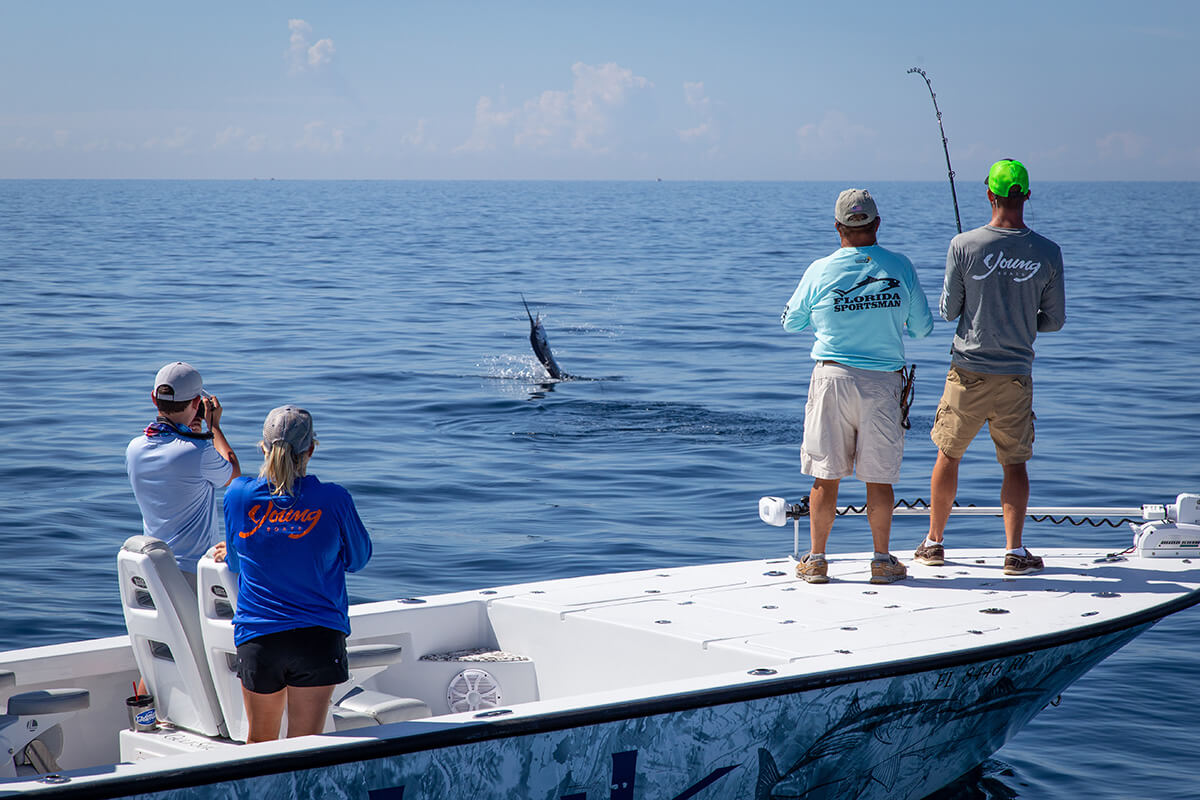
Fishing is more than a hobby—it’s a pursuit that blends adventure, relaxation, and the thrill of reeling in a catch. Whether you’re a seasoned angler chasing a record-breaking marlin or a novice eager to cast your first line, a fishing charter offers an unparalleled experience. Unlike DIY fishing trips, fishing charters provide expert guidance, top-notch equipment, and access to prime fishing spots, making them the ideal choice for anglers of all levels. In this comprehensive guide, we explore the compelling reasons to book a fishing charter for your next trip, from convenience and expertise to safety and unforgettable memories.
You may also like to read “ 10 Reasons to Love Jack Fish” article.
The Allure of Fishing Charters

Fishing Charter
Fishing charters are professionally guided boat trips led by experienced captains and crews who know their local waters inside and out. These services cater to everyone, from families seeking a fun outing to hardcore anglers targeting specific species. Charters range from half-day coastal trips to multi-day deep-sea expeditions, offering flexibility to suit your schedule and goals. The appeal lies in their ability to simplify logistics, enhance success rates, and deliver a tailored fishing experience that’s hard to replicate on your own.
Hassle-Free Planning and Convenience
Organizing a fishing trip can be overwhelming, especially in unfamiliar territory. Securing permits, renting or buying gear, and finding productive fishing spots require time and effort that can detract from the enjoyment of the experience. Fishing charters eliminate these hurdles by handling all the details. The crew provides rods, reels, bait, tackle, and fishing licenses, ensuring you’re ready to fish from the moment you board. For example, a group planning a trip to the Florida Keys can book a charter through FishingBooker, a trusted platform that connects anglers with vetted captains, making the process seamless. This convenience lets you focus on the excitement of fishing rather than the logistics of planning.
Access to Exclusive Fishing Grounds
One of the standout benefits of a fishing charter is access to prime fishing locations that are often out of reach for casual anglers. Charter captains spend years mastering their waters, from hidden reefs to offshore currents, and use advanced tools like fish finders and sonar to locate schools of fish. For instance, a charter in the Gulf of Mexico might take you to a secret grouper hotspot 30 miles offshore, a spot you’d never find without local expertise. This insider knowledge dramatically increases your chances of landing a trophy fish, making charters a smart choice for maximizing your catch.
Expertise That Transforms Your Trip
The expertise of a charter’s captain and crew is a game-changer, offering insights and skills that elevate your fishing experience. Whether you’re learning the basics or refining advanced techniques, their guidance ensures you get the most out of your time on the water.
Learning from Seasoned Professionals
Charter captains are often lifelong anglers with an intimate understanding of fish behavior, tides, and weather patterns. They can teach you techniques tailored to the local environment, such as bottom fishing for snapper or trolling for sailfish. For beginners, this hands-on instruction is invaluable. Picture a first-time angler on a charter in Puget Sound, learning to jig for salmon under the guidance of a captain who’s navigated these waters for decades. Even seasoned anglers benefit from local tips, as explored in our guide to advanced fishing techniques. This expertise accelerates your learning and boosts your success rate.
Tailored Experiences for Every Angler
Fishing charters are highly customizable, catering to a wide range of preferences and skill levels. Whether you’re a family looking for a relaxed day of reef fishing or a solo angler chasing a bucket-list species like tuna, the captain tailors the trip to your goals. For example, a group of friends on a charter in San Diego might target yellowtail for a fun, social outing, while a dedicated angler in the Outer Banks books a full-day trip for bluefin tuna. This flexibility ensures every trip aligns with your vision, delivering a personalized adventure.
Safety and Peace of Mind
Fishing, particularly in open waters, carries inherent risks, from unpredictable weather to navigational challenges. Fishing charters prioritize safety, providing a secure environment for you and your group.
Professional Navigation and Equipment
Charter boats are equipped with cutting-edge navigation systems, including GPS, radar, and weather monitoring tools, to ensure safe travel. Captains are trained to anticipate and avoid hazards, such as sudden storms or shallow shoals. Additionally, charter vessels undergo regular safety inspections and carry essential gear like life jackets, first-aid kits, and emergency radios, meeting standards set by organizations like NOAA Fisheries. For instance, a family fishing off Cape Cod can trust that their charter is prepared for any scenario, allowing them to relax and enjoy the trip.
Ideal for Families and Groups
Charters are particularly well-suited for groups with mixed experience levels, such as families or corporate teams. The crew handles tasks like baiting hooks, netting fish, and teaching beginners, reducing the risk of accidents. A parent taking their kids on a charter in the Chesapeake Bay, for example, can focus on making memories while the crew ensures everyone’s safety. This reliability makes charters a stress-free option for group outings, fostering fun and inclusivity.
The Social and Cultural Rewards of Charters
Beyond the catch, fishing charters offer social and cultural benefits that enrich the experience. These trips create opportunities for bonding, storytelling, and immersion in local traditions.
Fostering Connections Through Shared Adventures
A fishing charter is a social experience that strengthens relationships among friends, family, or colleagues. The shared thrill of reeling in a fish or joking about a missed catch creates lasting memories. For example, a family reunion on a charter in the Bahamas might center around a group effort to land a barracuda, sparking stories told for years. Charters also facilitate connections with other anglers, building a sense of community.
Immersing in Local Fishing Heritage
Charters provide a unique window into the culture and history of fishing communities. Captains often share tales of local marine life, fishing traditions, or historical figures tied to the area. A charter in Key West, for instance, might include stories of Ernest Hemingway’s legendary fishing exploits, adding depth to the trip. This cultural immersion transforms a fishing charter into a journey through the heart of a region’s maritime heritage, making it more than just a day on the water.
Fishing Charters vs. DIY Fishing: A Comparison
To illustrate why charters are the superior choice, let’s compare them to DIY fishing trips. The table below highlights key differences in cost, convenience, and outcomes.
| Aspect | Fishing Charter | DIY Fishing |
|---|---|---|
| Cost | Higher initial cost, includes gear, licenses, and expertise. | Lower cost, but requires buying/renting equipment and permits. |
| Convenience | All logistics managed; just show up and fish. | Requires scouting locations, planning, and gear maintenance. |
| Access to Spots | Exclusive access to prime fishing grounds with expert navigation. | Limited to public or known areas, often less productive. |
| Expertise | Professional guidance tailored to your skill level. | Relies on your knowledge, with potential for trial and error. |
| Safety | Equipped with safety gear and trained crew; ideal for groups. | Safety depends on your preparation and equipment quality. |
Cost vs. Value
While charters have a higher upfront cost, they offer exceptional value. The price covers equipment, fuel, licenses, and expertise, often making it more economical than outfitting a DIY trip. For example, a $600 half-day charter for a group of five can be cheaper than renting a boat, buying tackle, and securing permits. Plus, the higher success rate of charters means you’re more likely to return with fish, maximizing your investment.
Time and Effort Savings
DIY fishing demands significant time for research, planning, and gear maintenance. Charters save you this effort, letting you focus on fishing. A busy professional booking a charter in Miami, for instance, can enjoy a full day of tarpon fishing without spending hours scouting spots. This efficiency makes charters ideal for those with limited time or local knowledge.
Conclusion
A fishing charter is the ultimate way to elevate your next fishing trip, offering convenience, expertise, safety, and unforgettable moments. From accessing exclusive fishing grounds to learning from seasoned professionals, charters deliver a tailored experience that DIY trips can’t match. They foster connections, immerse you in local culture, and ensure every angler—novice or expert—leaves with stories to tell. Whether you’re casting in the Florida Keys or battling fish in the Pacific Northwest, a charter provides the tools and guidance for a successful adventure.
Don’t settle for the uncertainties of a solo fishing trip. Book a fishing charter and let the experts guide you to the catch of a lifetime. With their knowledge, passion, and resources, you’ll discover why charters are the gold standard for anglers seeking thrill, relaxation, and reward.
Equipment
The Ultimate Guide to Cooking Frozen Shrimp in Air Fryer
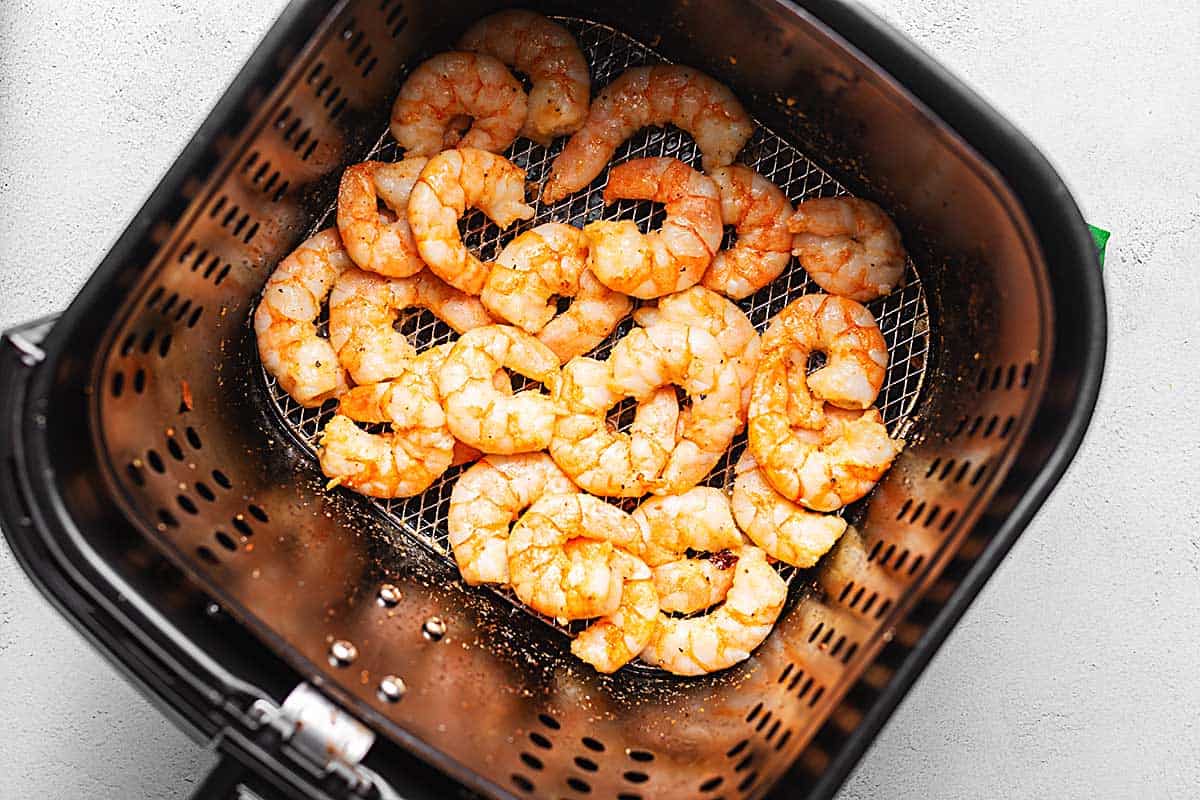
Cooking frozen shrimp in air fryer has become increasingly popular due to its convenience and consistently delicious results. This comprehensive guide will help you master the art of preparing crispy, juicy shrimp straight from frozen using your air fryer.
You may also like to read “ How to Cook Frozen Shrimp Perfectly” article.
Why Choose Air Fryer for Frozen Shrimp

Air Fryer
Air fryers have revolutionized home cooking, and according to the FDA’s Food Safety Guidelines, they’re an excellent tool for cooking frozen seafood safely and efficiently.
Benefits of cooking frozen shrimp in air fryer
Table: Air Fryer vs. Traditional Cooking Methods
| Cooking Method | Cooking Time | Oil Usage | Texture Result |
|---|---|---|---|
| Air Fryer | 8-10 minutes | 1-2 tsp | Crispy exterior |
| Oven Baking | 15-20 minutes | 2-3 tbsp | Less crispy |
| Pan Frying | 10-12 minutes | 1/4 cup | Variable results |
| Boiling | 5-7 minutes | None | Softer texture |
Preparing Frozen Shrimp in Air Fryer
Selecting the Right Shrimp
For the best results, choose high-quality frozen shrimp. Visit Seafood Watch for sustainable seafood recommendations.
Table: Shrimp Size Guide for Air Fryer
| Size Category | Count per Pound | Cooking Time |
|---|---|---|
| Extra Large | 26-30 | 10-12 mins |
| Large | 31-35 | 8-10 mins |
| Medium | 41-50 | 7-9 mins |
| Small | 51-60 | 6-8 mins |
Pre-Cooking Preparation
- Initial Assessment
- Check for ice crystals
- Separate frozen pieces
- Remove any broken pieces
- Assess quantity for batches
Basic Frozen shrimp in Air Fryer Recipe

Frozen Shrimp in Air Fryer
Essential Ingredients
Table: Basic Recipe Components
| Ingredient | Amount | Purpose |
|---|---|---|
| Frozen Shrimp | 1 pound | Main protein |
| Olive Oil | 1-2 tsp | Coating |
| Garlic Powder | 1 tsp | Seasoning |
| Sea Salt | 1/2 tsp | Flavor |
| Black Pepper | 1/4 tsp | Seasoning |
Step-by-Step Process
- Preparation Phase
Begin with your frozen shrimp and basic seasonings. No thawing is required, which makes this method incredibly convenient for quick meals. - Seasoning Application
Even though the shrimp are frozen, seasonings will adhere effectively during cooking. Coat them lightly with oil and seasonings just before air frying.
Temperature and Timing Guidelines
Optimal Cooking Settings
Table: Temperature Guide by Shrimp Size
| Shrimp Size | Temperature | Time | Flip Timing |
|---|---|---|---|
| Jumbo | 400°F | 10-12 min | 6 minutes |
| Large | 390°F | 8-10 min | 5 minutes |
| Medium | 380°F | 7-9 min | 4 minutes |
| Small | 370°F | 6-8 min | 3 minutes |
Advanced Cooking Techniques
Batch Cooking Strategy
For optimal results when cooking larger quantities:
- First Batch Process
- Preheat air fryer
- Arrange shrimp
- Monitor closely
- Adjust timing
- Subsequent Batches
- Maintain temperature
- Adjust timing slightly
- Check doneness
- Keep warm method
Flavor Variations
Popular Seasoning Combinations
Table: Seasoning Profiles and Ingredients
| Style | Primary Seasonings | Additional Elements |
|---|---|---|
| Garlic Parmesan | Garlic, Parmesan | Italian herbs |
| Cajun | Cayenne, Paprika | Onion powder |
| Lemon Pepper | Lemon zest, Black pepper | Dried herbs |
| Asian Fusion | Soy sauce, Ginger | Sesame oil |
Serving Suggestions
Complementary Sides
Perfect pairings for your air-fried shrimp:
- Light Options
- Fresh salad greens
- Steamed vegetables
- Citrus rice
- Quinoa pilaf
- Hearty Combinations
- Pasta dishes
- Grain bowls
- Roasted potatoes
- Mixed vegetables
Troubleshooting Common Issues
Problem-Solving Guide
Table: Common Issues and Solutions
| Problem | Possible Cause | Solution |
|---|---|---|
| Rubbery Texture | Overcooking | Reduce time |
| Uneven Cooking | Overcrowding | Cook in batches |
| Dry Shrimp | High temperature | Lower heat |
| Not Crispy | Excess moisture | Pat dry, increase temp |
Storage and Reheating
Proper Storage Methods
Keep your cooked shrimp fresh:
- Short-term Storage
- Airtight container
- Refrigerate promptly
- Use within 3 days
- Proper cooling
- Reheating Process
- Air fryer: 2-3 minutes
- Avoid microwave
- Check temperature
- Serve immediately
Health and Nutrition Benefits
Nutritional Information
Table: Nutritional Values per 4 oz Serving
| Nutrient | Amount | % Daily Value |
|---|---|---|
| Protein | 24g | 48% |
| Calories | 120 | 6% |
| Fat | 1.7g | 3% |
| Cholesterol | 170mg | 57% |
Safety Considerations
Food Safety Guidelines
Important safety measures:
- Temperature Control
- Internal temperature
- Cooking consistency
- Safe handling
- Storage temps
- Equipment Care
- Regular cleaning
- Proper maintenance
- Temperature checks
- Safety features
Advanced Tips for Perfect Results
Professional Insights
Expert recommendations for the best outcomes:
- Quality Indicators
- Color changes
- Texture assessment
- Aroma development
- Visual cues
- Timing Perfection
- Size considerations
- Quantity adjustments
- Temperature monitoring
- Doneness tests
Conclusion
Air frying frozen shrimp offers a quick, healthy, and delicious way to prepare this popular seafood. The key advantages include:
- Consistent results
- Minimal preparation
- Healthy cooking method
- Versatile applications
Remember these essential points:
- Proper temperature control
- Appropriate batch sizing
- Regular monitoring
- Seasoning balance
With these guidelines, you can confidently prepare perfectly cooked frozen shrimp in air fryer every time. Whether you’re making a quick weeknight dinner or preparing appetizers for guests, this method provides reliable, delicious results with minimal effort.
The combination of convenience, health benefits, and excellent taste makes air fryer frozen shrimp an ideal choice for any meal. By following these detailed instructions and experimenting with different seasonings and serving suggestions, you’ll master this cooking technique and add a valuable skill to your culinary repertoire.
Equipment
Ice Fishing Tent: The Ultimate Guide to Choosing and Using Ice Shelters
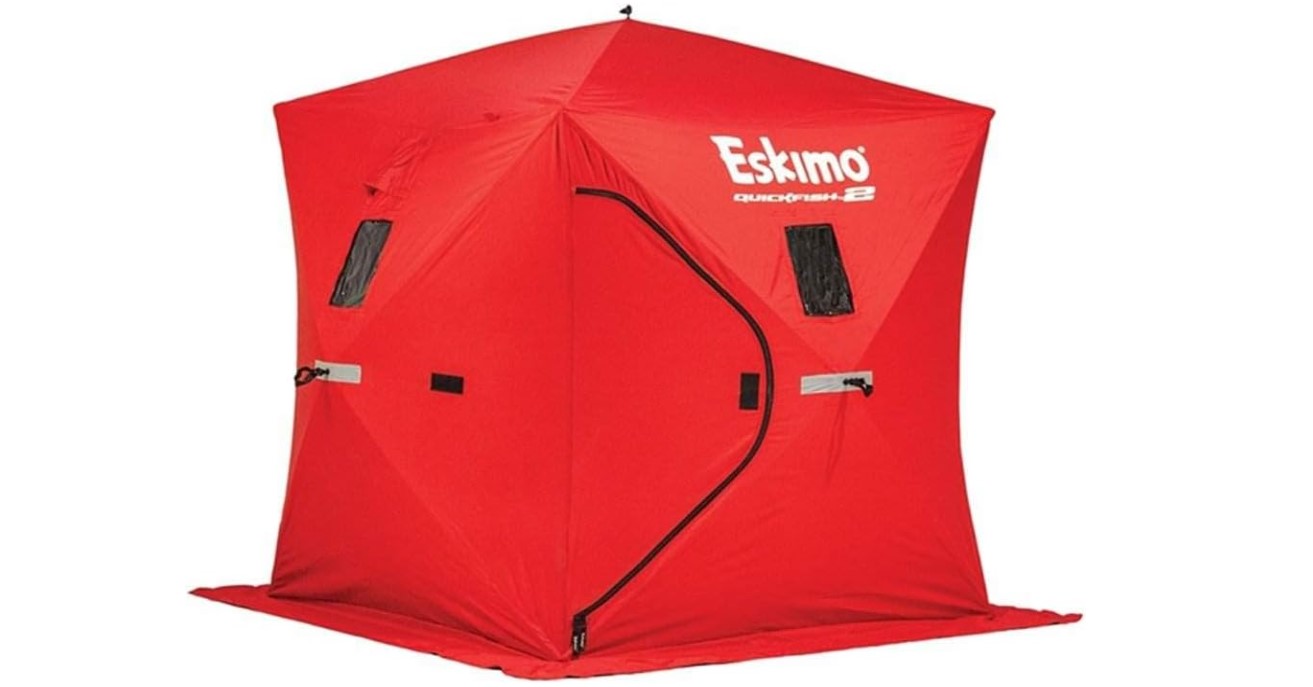
Ice fishing tents, also known as ice shelters or shanties, are essential pieces of equipment that transform winter fishing from a cold endurance test into a comfortable and enjoyable experience. This comprehensive guide will help you understand everything you need to know about ice fishing tents, from selection to maintenance.
You may also like to read “ What is Special About Ice Fishing?” article.
Understanding Ice Fishing Tents
Types of Ice Shelters

Ice Fishing Tent
Different styles of ice fishing shelters serve various needs and preferences. Let’s explore the main categories:
- Pop-up Shelters
These portable shelters offer:
- Quick setup and takedown
- Lightweight construction
- Easy transportation
- Flexible sizing options
- Flip-over Shelters
Popular among mobile anglers for:
- Built-in sled base
- Rapid deployment
- Integrated seating
- Equipment storage
- Hub-style Shelters
Preferred for longer stays due to:
- Maximum interior space
- Superior stability
- Multiple entry points
- Better standing room
For expert reviews and comparisons, visit In-Depth Outdoors Ice Shelter Reviews.
Essential Features to Consider
Size and Capacity
Table: Shelter Size Guide
| Shelter Size | Angler Capacity | Approximate Weight | Best Use Case |
|---|---|---|---|
| 1-2 Person | 1-2 anglers | 15-25 lbs | Solo/Partner fishing |
| 3-4 Person | 2-4 anglers | 25-40 lbs | Small group trips |
| 5+ Person | 4-8 anglers | 40-70 lbs | Large groups/Extended stays |
Material Quality
Superior ice fishing tents feature:
- Exterior Fabric
- 300-600 denier fabric
- Waterproof coating
- UV protection
- Wind resistance
- Frame Construction
- Aircraft-grade aluminum
- Reinforced stress points
- Flexible yet durable design
- Corrosion resistance
Top Features for Comfort
Insulation and Ventilation
Modern ice shelters incorporate:
- Thermal Properties
- Multi-layer insulation
- Heat-reflective interior
- Draft prevention
- Condensation management
- Ventilation Systems
- Adjustable vents
- Ice fishing hole covers
- Window options
- Door design
For more information about ice fishing equipment, check out Take Me Fishing’s Ice Fishing Guide.
Popular Brands and Models
Top Manufacturers
Table: Leading Ice Shelter Brands Comparison
| Brand | Known For | Price Range | Warranty |
|---|---|---|---|
| Clam | Durability | $$-$$$ | 3 years |
| Eskimo | Value | $-$$ | 1 year |
| Otter | Quality | $$-$$$ | 3 years |
Key Models Analysis
- Hub-Style Excellence
Popular models feature:
- Quick-deploy hubs
- Reinforced corners
- Multiple entry points
- Storage solutions
- Flip-Style Innovation
Leading designs include:
- Integrated sleds
- Bench seating
- Rod storage
- Tackle organization
Setting Up Your Ice Shelter
Basic Setup Process
Proper setup ensures optimal performance:
- Site Selection
Consider factors like:
- Ice thickness
- Wind direction
- Fishing location
- Surface conditions
- Assembly Steps
Follow this sequence:
- Clear the area
- Position the base
- Deploy the frame
- Secure anchor points
Maintenance and Care
Proper Storage
Extend your shelter’s life through:
- Cleaning Procedures
- Remove ice and snow
- Dry thoroughly
- Clean fabric surfaces
- Inspect for damage
- Storage Conditions
- Keep in dry location
- Avoid direct sunlight
- Use storage bags
- Maintain ventilation
Advanced Features
Technology Integration
Modern ice shelters may include:
- Lighting Systems
- LED integration
- Battery power
- Multiple brightness levels
- Emergency backup
- Electronic Compatibility
- Power ports
- Device mounts
- Sonar openings
- Camera supports
Safety Considerations
Weather Protection
Essential safety features include:
- Wind Resistance
- Proper anchoring
- Reinforced structure
- Wind blocks
- Emergency ties
- Temperature Management
- Insulation rating
- Heat retention
- Ventilation control
- Emergency exits
Cost Analysis
Investment Considerations
Understanding cost factors:
Table: Cost-Benefit Analysis
| Price Range | Features | Best For | Long-term Value |
|---|---|---|---|
| $100-300 | Basic protection | Occasional use | Entry-level |
| $300-600 | Better insulation | Regular use | Mid-range |
| $600+ | Premium features | Frequent use | Professional |
Customization Options
Personalizing Your Shelter
Popular modifications include:
- Storage Solutions
- Custom shelving
- Rod holders
- Gear organizers
- Tool mounts
- Comfort Upgrades
- Seating improvements
- Flooring options
- Lighting additions
- Heating solutions
Environmental Impact
Eco-Friendly Options
Sustainable considerations:
- Material Selection
- Recyclable materials
- Durable construction
- Repair-friendly design
- Low-impact manufacturing
- Energy Efficiency
- Improved insulation
- LED lighting
- Solar options
- Reduced waste
Tips for Usage
Maximizing Efficiency
Best practices include:
- Setup Optimization
- Practice at home
- Mark anchor points
- Create checklist
- Monitor weather
- Interior Organization
- Designated areas
- Equipment placement
- Access planning
- Safety equipment
Seasonal Considerations
Year-round Care
Maintain your shelter through:
- Off-season Storage
- Clean thoroughly
- Repair damage
- Document condition
- Protect from elements
- Pre-season Prep
- Test setup
- Check components
- Replace parts
- Update modifications
If you are looking for a Super ice fishing tent try this Eskimo Quickfish tent.
Conclusion
Selecting the right ice fishing tent is crucial for enjoying winter fishing to its fullest. Consider these key factors when making your choice:
- Intended use frequency
- Number of anglers
- Transportation needs
- Budget constraints
- Desired features
Remember that a quality ice fishing tent is an investment in:
- Comfort and safety
- Extended fishing time
- Better fishing experience
- Equipment protection
Whether you’re a casual weekend angler or a dedicated ice fishing enthusiast, the right shelter can make all the difference in your winter fishing success. Take time to research, compare options, and choose a shelter that meets your specific needs.
The evolution of ice fishing tent technology continues to improve the sport, making it more accessible and enjoyable for anglers of all experience levels. By understanding the features, maintenance requirements, and proper usage of ice fishing tents, you can make an informed decision that will enhance your winter fishing adventures for years to come.
-

 Fishing Guides1 year ago
Fishing Guides1 year agoThe Secret to Catching More Catfish: Chicken Gizzards as Bait
-
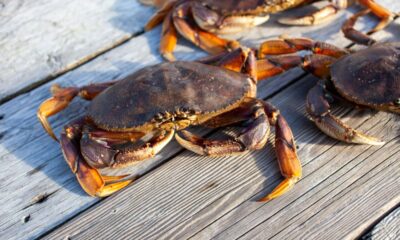
 Fishing Guides3 months ago
Fishing Guides3 months agoWhy Is Dungeness Crab Season So Popular?
-

 Fishing Guides1 year ago
Fishing Guides1 year agoA Beginner’s Guide to Smallmouth Bass Fishing
-
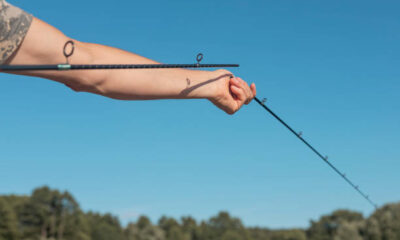
 Equipment8 months ago
Equipment8 months agoHow to Repair a Broken Fishing Rod Tip Like a Pro
-

 Fishing Guides1 year ago
Fishing Guides1 year agoThe Truth About Mullet Fish: Is It a Delicious and Nutritious Fish?
-
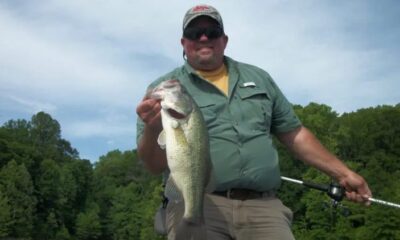
 Fishing Guides1 year ago
Fishing Guides1 year agoUncovering the Secrets of Bluegill Largemouth Bass Hybrids: What You Need to Know
-

 Fishing Guides1 year ago
Fishing Guides1 year ago10 Secrets to Successful Full Moon Fishing
-

 Fishing Guides11 months ago
Fishing Guides11 months agoHow to Trap Snapping Turtles Safely: Every tip you need to know
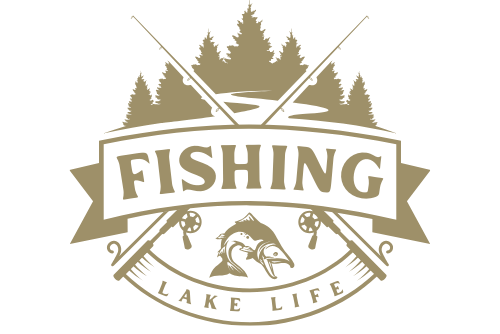

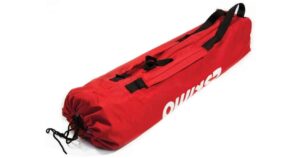





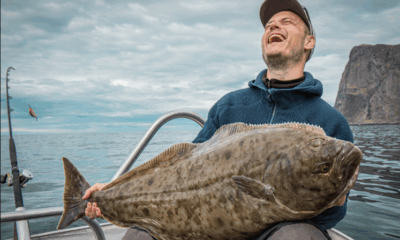
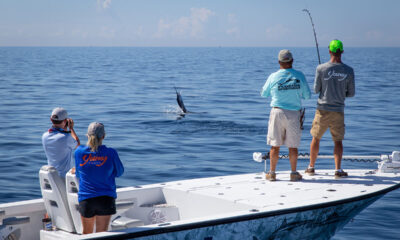
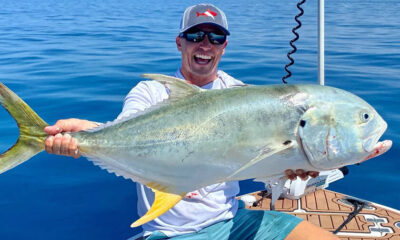
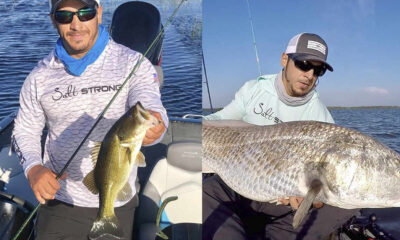
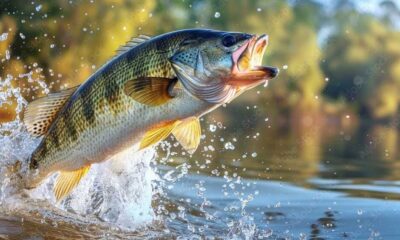
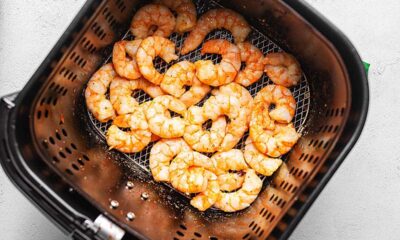





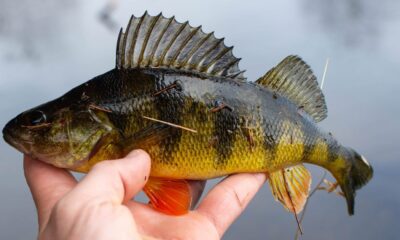

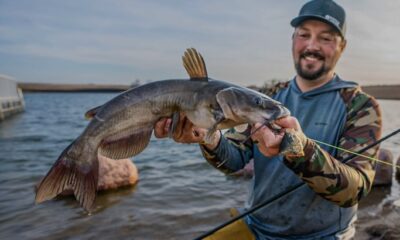

Pingback: Master the Double Jig Rig: A Game-Changer for Crappie Fishing - Lake Life Fishing